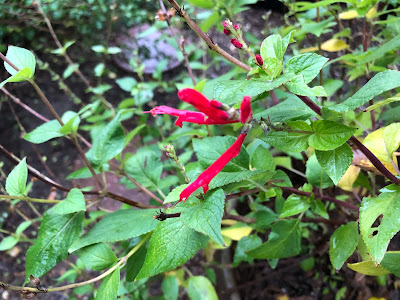
A perfect time to catch up on gardening info

|
|
Even a little bit of color stands out on a grey day:
The last red blossoms on a thriving pineapple sage.
(Photo: Kathy Morrison)
|
This late in December I don't have much time to garden even when the sun is out. The current rain system has kept me mostly indoors, where it's warm and cozy. Between flurries of gift wrapping and cooking, I can sit down with a big mug of coffee and catch up with articles and posts.
Do you follow The Garden Professors? They have an excellent blog, offering science-based reports and advice. But it's not humorless -- a clip from the movie "Mame" is included in the latest one.
Linda Chalker-Scott is maybe the best known of the writers, from her work dispelling garden myths and her book "How Plants Work." Her fellow bloggers include Jim Downer, Pam Knox, John Porter and Sylvia Thompson-Hacker. They also have an active Facebook group , where participants post questions and information, but it's private, and readers must promise to follow the very specific rules before they're allowed to join.
Here are a few of the gardenprofessors.com posts I stashed away recently to read and refer to:
-- Haul Out the Holly ... and a cactus ... and a parasite: A review of holiday plants and their traditions, by John Porter.
-- Pruning Mature Shade Trees , by Jim Downer. This post is an invaluable reference, and includes several pictures of older trees maligned by poor pruning. "Large trees bear the burden of their insults over the years," he writes. Yikes.
-- Poinsettias: from ditch weed to holiday super star (history, lore, and how to get those d@!% things to rebloom next year), by John Porter. Yes, you can get that holiday brightener to rebloom. But it takes some work. Porter also discusses the fascinating history of the poinsettia and how it came to be such a prominent Christmas plant.
-- Why root washing is important: An illustrated cautionary tale . Root washing is a huge topic with Linda Chalker-Scott, and it's an especially important technique for anyone putting in new landscape plants. Root washing is a method of releasing and correcting the root system of plants grown -- stuffed into! -- nursery pots, especially trees. As she notes, "Leaving rootballs intact creates textural discontinuities between the roots and the native soil, and poorly structured woody roots are not going to correct themselves."
Videos on YouTube of course are always good gardening references, but it's easy to get caught up in ones that have no real relevance to Sacramento-area gardens. These videos are iron-clad local, and perfect for winter:
Composting: Getting started and Composting: Hot vs Cold with Susan Muckey of the Sacramento County master gardeners.
Shopping for bare-root fruit trees with Ed Laivo of Dave Wilson Nursery.
Grafting fruit trees with Tom Spellman of Dave Wilson Nursery.
Identifying and removing suckers on citrus trees with Kerry Beane of Four Winds Growers.
Pruning woody sages with Pat Schink of the Sacramento master gardeners. This video includes growing season and dormant season (winter) pruning of salvias. My sages and salvias looked better than ever this past year, thanks to these pruning guidelines.
Comments
0 comments have been posted.Sacramento Digs Gardening to your inbox.
Food in My Back Yard Series
April 1: Don't be fooled by these garden myths
March 25: Fertilizer tips: How to 'feed' your vegetables for healthy growth
March 18: Time to give vegetable seedlings some more space
March 11: Ways to win the fight against weeds
March 4: Potatoes from the garden
Feb. 25: Plant a fruit tree now -- for later
Feb. 18: How to squeeze more food into less space
Feb. 11: When to plant? Consider staggering your transplants
Feb. 4: Starting in seed starting
Sites We Like
Garden Checklist for week of March 30
Your garden doesn’t mind April showers. Get busy now to enjoy those future flowers.
* Get ready to swing into action in the vegetable garden. As nights warm up over 50 degrees, start setting out tomato, pepper and eggplant transplants.
* From seed, plant beans, beets, cantaloupes, carrots, corn, cucumbers, melons, pumpkins, radishes and squash. (Soak beet seeds overnight in water for better germination,)
* Plant onion sets.
* In the flower garden, plant seeds for asters, cosmos, celosia, marigolds, salvia, sunflowers and zinnias.
* Transplant petunias, zinnias, geraniums and other summer bloomers.
* Plant perennials and dahlia tubers for summer bloom.
* Transplant lettuce and cabbage seedlings.
* April is the last chance to plant citrus trees such as dwarf orange, lemon and kumquat. These trees also look good in landscaping and provide fresh fruit in winter.
* Smell orange blossoms? Feed citrus trees with a low dose of balanced fertilizer (such as 10-10-10) during bloom to help set fruit. Keep an eye out for ants.
* Apply slow-release fertilizer to the lawn.